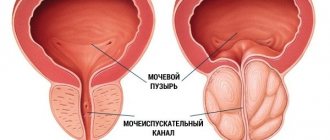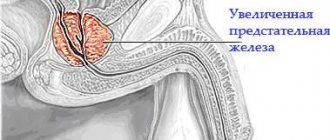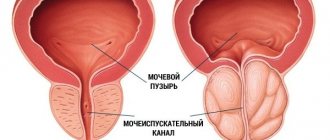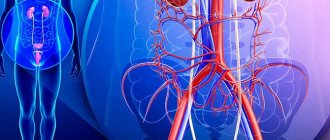Published: 06/22/2021 11:30:00 Updated: 06/22/2021
Prostatitis is an inflammation of the prostate gland, one of the common problems in 40% of middle-aged and older men [5]. Without directly threatening life, this disease leads to a significant decrease in its quality, affecting performance, the intimate sphere, limiting freedom and provoking everyday difficulties and psychological disorders.
Prostatitis occurs in acute or chronic form and can be of infectious or non-infectious origin.
Causes of prostatitis
The causes of prostatitis are varied: the acute form is associated with a bacterial infection that enters the prostate gland through the ascending route during urological and venereal diseases of an infectious nature, chronic prostatitis in 90% of cases is not associated with infections [2, 3, 5, 6]. Stagnation of prostate secretion is formed both as a result of infectious inflammation of the duct walls and systemic diseases [5].
Causes of acute prostatitis
Acute bacterial prostatitis is caused by enterobacteria, Gram-negative and Gram-positive cocci [5], chlamydia, mycoplasma [4], and viruses [2, 3].
Risk factors for prostate infection are sexually transmitted diseases and invasive urological interventions (catheterization, instillation and diversion of the urethra, urocystoscopy) [6]. Provocateurs for the development of infectious inflammation are usually hypothermia, prolonged constipation or diarrhea, sedentary work, excessive sexual activity or sexual abstinence, chronic sexually transmitted and urological diseases, suppressed immune response, lack of sleep, overtraining, chronic stress. By worsening the blood supply to the pelvic organs, these factors themselves contribute to aseptic inflammation and also facilitate the introduction of the pathogen into the prostate tissue [6].
Acute bacterial inflammation can resolve without consequences, but in some cases the following complications develop:
- acute urinary retention;
- chronic prostatitis (chronic inflammatory pelvic pain syndrome);
- epididymitis;
- prostate abscess;
- fibrosis of prostate tissue;
- infertility [1, 2, 4, 5].
Causes of chronic prostatitis
In 10% of cases, chronic prostatitis develops as a complication of acute inflammation of the prostate gland, as well as urethritis, chlamydia, human papillomavirus and other chronic infections [4].
About 90% are due to nonbacterial chronic prostatitis or chronic pelvic pain syndrome (CPPS) [1, 4, 5]. This form of the disease is not associated with infections, but is due to many reasons, primarily stagnant processes in the pelvis. Stagnation of urine, causing inflammation, is formed against the background of urethritis, neurogenic narrowing of the bladder neck, urethral stricture, and autoimmune inflammation [5]. The blood supply to the pelvic organs deteriorates, which is explained by systemic cardiovascular diseases (CHD, atherosclerosis) [2]. The common venous system of the small pelvis determines the connection of chronic prostatitis with anal fissures, hemorrhoids, proctitis, and fistulas [3]. Chronic pelvic pain in men is associated with:
- low physical activity;
- low levels of testosterone in the blood;
- changes in the microbial environment of the body;
- genetic and phenotypic predisposition [4].
How to prevent chronic prostatitis
After completing a course of therapeutic measures to treat prostatitis, it is very important to prevent relapse. To avoid exacerbation of the chronic form of the disease, men should:
- have regular sex life (preferably with the same partner);
- during casual sexual intercourse, use a condom;
- give up bad habits (smoking, drinking alcohol);
- lead an active life, play sports;
- avoid hypothermia.
Symptoms of prostatitis
- Fever (from 38-39 degrees Celsius for acute prostatitis and low-grade fever for chronic prostatitis).
- Urinary dysfunction: frequent urge to urinate, not always effective, difficulty or increased frequency of urination, especially at night. The urine stream is depleted, and there is always some residual amount in the bladder.
- Prostate damage: leukocytes and blood in semen, pain during urological examination.
- Fibromyalgia.
- Prostatorrhea is a small discharge from the urethra.
- Pain in the pelvis, perineum, testicles, above the pubis, penis, sacrum, bladder, scrotum.
- Painful urination and ejaculation [2, 6].
- Convulsive muscle spasms.
- Stones in the prostate gland.
- Chronic fatigue, a feeling of hopelessness, catastrophe, psychological stress against the background of chronic pain syndrome.
- Decreased performance (asthenia), decreased mood, irritability).
- Sexual dysfunction – erectile dysfunction, premature ejaculation, lack of orgasm.
- Irritable bowel syndrome and proctitis may occur [3, 5, 6].
In the chronic course of the disease, the signs of prostatitis are blurred (less pronounced), but they are accompanied by general, neurological and mental symptoms [6].
Instrumental research methods
TRUS (transrectal ultrasound) is performed using equipment equipped with an instrument that is inserted into the patient's rectum. If a hypoechoic area of irregular shape is detected, there is every reason to suspect a malignant neoplasm. With chronic prostatitis, scarring, compaction of the structure of glandular tissue, and changes in the seminal vesicles may be observed.
UDI is the main method of functional diagnostics. It allows you to find out the nature of urination, signs of stagnation of urine, and its composition. The study includes several tests: uroflowmetry, cystometry, measurement of residual urine volume, assessment of pressure inside the bladder and urine outflow rate.
Tomography (computed or magnetic resonance imaging) is necessary to exclude benign and malignant neoplasms. These research methods are highly informative and help assess the condition of prostate tissue.
Diagnosis of prostatitis
The key to successful and timely treatment of prostatitis is an accurate and comprehensive diagnosis.
The low proportion of infectious prostatitis is explained in most cases by the fact that the pathogen was not detected. Chronic sexually transmitted infections can be asymptomatic, while their pathogens can penetrate the prostate tissue and cause inflammation. Therefore, laboratory research methods play a leading role in the diagnostic process. To determine the sensitivity of bacteria to antibiotics, biological fluids are inoculated: urine, semen, prostate secretions. This method allows you to select a drug that is most effective for a specific pathogen strain, capable of penetrating directly to the site of inflammation [5].
The “classical” method of laboratory diagnosis of prostatitis is considered cultural (culture of urine, ejaculate, contents of urogenital smears). The method is very accurate, but takes time. To detect bacteria, a smear is Gram stained, but in this way it is unlikely to detect viruses, mycoplasma and ureaplasma [5]. To increase the accuracy of research, mass spectrometry and PCR (polymerase chain reaction) are used [4]. Mass spectrometry is the ion analysis of the structure of a substance and the determination of each of its components. The polymerase chain reaction allows you to detect fragments of DNA or RNA of the causative agent of an infectious disease, including viruses and plasma.
Currently, for a special examination of urological patients, the Androflor analysis is used - a comprehensive PCR study of the microflora of the genitourinary tract. The result of the study is ready in a day and reflects the complete picture of the microbial ratio in the body of the subject.
Tests for prostatitis include collection of urine and ejaculate and urological smears. The European Urological Association recommends the following set of laboratory tests:
- general urine analysis;
- bacterial culture of urine, semen and ejaculate;
- PCR diagnostics.
A general urine test allows you to determine signs of inflammation (the number of colony-forming units of microorganisms, the number of leukocytes, red blood cells, urine clarity) and the presence of calcifications (prostate stones).
General analysis is included in the methodology of several urological (glass or portion) samples. Glass or portion samples consist of sequential collection of urine or other biological fluids into different containers. In this way, the localization of the infectious process is determined. Prostatitis is indicated by the detection of infectious agents, blood cells (leukocytes and erythrocytes) in the final portion of urine during a three-glass sample or after urological massage of the prostate
Two-glass test - inoculation of the middle part of the urine stream before and after urological prostate massage.
Three-glass sample - the initial, middle and final portions of urine are taken during the same urination.
Four-glass test - culture and general analysis of the initial and middle parts of the urine stream, prostate secretion after urological prostate massage and a portion of urine after this procedure.
Cultural culture or PCR diagnostics of ejaculate [4, 5] and urogenital smear material are also performed.
To make a diagnosis of prostatitis, blood tests are also required. A general capillary blood test allows you to confirm or refute the presence of inflammation, as well as exclude other diagnoses that cause the same symptoms.
Diagnosis of non-inflammatory chronic pelvic pain syndrome is more difficult, as it is based on the clinical picture and indirect laboratory indicators (including general analysis of urine and blood). The intensity of the pain syndrome is determined using a visual analog pain scale, and the severity of psychological changes is determined using scales for assessing anxiety and depression. At the same time, research is required to search for an infectious agent, since the range of pathogens can be very wide. Instrumental studies include urofluometry with determination of residual urine volume and transrectal ultrasound examination (TRUS) of the prostate gland [1, 5].
Asymptomatic prostatitis is detected by histological examination of a prostate biopsy specimen, prescribed for suspected cancer. A blood test for Prostate Specific Antigen (PSA) is performed first. PSA in the blood serum appears with hypertrophy and inflammation of the prostate, and the normal criteria change with age. This study also helps to exclude suspicions of a malignant prostate tumor [1, 2, 3].
Laboratory research methods
If chronic prostatitis is suspected, first of all they find out what its nature is: bacterial or abacterial. In the first case, it is necessary to identify the pathogen or pathogens and find out which drugs they are sensitive to. To do this, laboratory tests of urine and prostate secretions are performed.
If, after a 10-day period after the DRE, the PSA test shows that the level of prostate-specific antigen exceeds 4.0 ng/ml, this is a reason to refer the patient for a biopsy in order to exclude an oncological process.
The following research methods are recommended:
- scraping from the urethra;
- general and biochemical urine analysis;
- LHC urine culture;
- LHC culture of prostate secretion.
Treatment and prevention of prostatitis
Treatment of acute prostatitis is carried out with antibiotics (fluoroquinolines and cephalosporins, macrolides), alpha-blockers, non-steroidal anti-inflammatory drugs, neuromodulators.
Few antibiotics are able to penetrate the prostate gland; pathogens are immune to some drugs, so bacterial culture is necessary [4]. Conservative urological treatment may also include acupuncture, herbal medicine, remote shock wave therapy, thermal physiotherapeutic procedures (after acute inflammation), massage [4].
Prevention of prostatitis includes both medical procedures and the formation of healthy habits:
- use of barrier contraceptives;
- regular sexual activity in conditions of minimized risk of infection;
- physical activity;
- elimination of deficiency conditions - hypo- and avitaminosis, mineral deficiency;
- compliance with aseptic conditions and careful technique for performing invasive urological interventions;
- regular preventive examinations using laboratory tests.
Nutrition
Nutrition should be balanced, rich in protein, and free of cholesterol.
It is useful to include a handful of pumpkin seeds, fresh berries and honey in your daily diet. It is important to consider all these recommendations in conjunction with therapy (including medication) prescribed by a doctor. For example, the standard treatment regimen for chronic bacterial prostatitis involves taking antibiotics, NSAIDs, and sometimes antidepressants.
Bibliography
- On the pathogenesis and prevention of chronic prostatitis (clinical and experimental study) / S.H. Al-Shukri, A.G. Gorbachev, S.Yu. Borovets, A.G. Tyurin, I.V. Knyazkin // Urological Gazette, 2012. - “2, vol. 2. - P. 15-18.
- Diagnosis of chronic abacterial prostatitis / Z.A. Kadyrov, V.S. Stepanov, Sh.V.Ramishvili, Sh.G Mashaneishvili // Andrology and genital surgery, 2021.- No. 3(20) – P.36-42 DOI: 10.17650/2070-9781-2019-20-3-00-00 .
- Clinical, laboratory and instrumental research methods in patients with chronic prostatitis and chronic hemorrhoids / Z.A. Kadyrov, Kryachko A.A. Z.O. Aliyev et al., // Andrology and genital surgery, 2021.- No. 17(17).-P. 34-38.
- Prostatitis: what is new and useful in fundamental and clinical research? / K.L. Lokshin // Bulletin of Urology, 2021.- No. 5(4).- P.69-78.
- Acute and chronic prostatitis - what is important for practice?/ K.G. Naber et al.// Bulletin of Urology, 2021.- No. 2.- P. 71-80.
- Chronic prostatitis: current issues of diagnosis and treatment at the stage of primary specialized and health care / D.I. Trukhan, D.G. Makushin, N.V. Bagisheva // International Journal of Applied and Basic Research. – 2021. – No. 6 (part 2) – P. 285-291.
Author:
Baktyshev Alexey Ilyich, General Practitioner (family doctor), Ultrasound Doctor, Chief Physician











